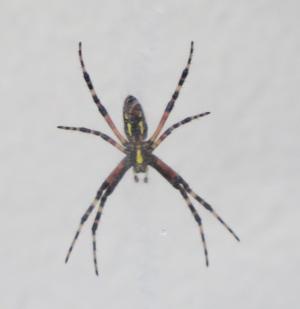
The silken threads are tossed on gentle breeze,
affixed where victim's desperate plight begins.
So thin, transparent, that one seldom sees
a woven grid that spider deftly spins --
the waiting web.
The spider clings with lithe and lethal legs,
on which it springs to capture those ensnared.
No matter how the vanquished victim begs,
once bitten, then, it soon becomes impaired.
Life forces ebb.
This patient predator's snagged prey are doomed,
with venom full of enzymes that dissolve.
A creature to vibrations fine attuned
to silken pathways, finds its world revolves
upon the web.
|
Author Notes
I captured a photo of this spider near my house wall the other day. It is a common American Grass Spider. Its web didn't show up in the photo, but was definitely there. It was strung between the arms of my house's hose keeper wheel. This spider was on its web, but facing my house, so this is its underside.
Agelenopsis is a genus of spiders, known as American Grass Spiders. They weave sheet webs that have a funnel shelter on one edge. The web is not sticky, but these spiders make up for that shortcoming by running very rapidly. The larger specimens (depending on species) can get up to approximately 5.5 inches(19 mm) in body length. Their bite releases agatoxins that cause rapid paralysis in insect prey, though their venom is not medically significant to humans. Thank goodness. Source: Wikipedia.
This poem is a Cat-a-strophe poem.
I called this format a Cat-a-strophe.
A Cat-a- strophe, as first reviewed in I Am Cat's lovely poem titled, "In Martha's Vineyard", (July 4th, 2016). It is a play on the word "catastrophe". Of course "Cat" because the from was created by our own Catherine Ginn. A "Strophe" is actually a poetic term that is also known as a "Volta" or turn. The format consists of any number of Quatrains, followed by a single line, which is written in iambic pentameter. It is written with a rhyme scheme of:
abab, c, dede, c, fgfg, c, hihi, c (and so on).
After each quatrain is a four syllable line which rhymes with all the other single lines (c rhyme).
I dubbed the style of this poem, a 'Cat-a-strophe', however the creator herself has not acknowledged nor endorsed the name. Any negative feedback concerning the name should be directed at me, not her. Dean Kuch dubbed this form a "Cat-o-tonic. I guess Cat will decide.
|
|
